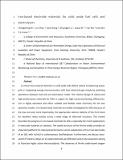Files in this item
Iron-based electrode materials for solid oxide fuel cells and electrolysers
Item metadata
| dc.contributor.author | Ni, Chengsheng | |
| dc.contributor.author | Zhou, Jun | |
| dc.contributor.author | Zhang, Ziye | |
| dc.contributor.author | Li, Shuangbin | |
| dc.contributor.author | Ni, Jiupai | |
| dc.contributor.author | Wu, Kai | |
| dc.contributor.author | Irvine, John T. S. | |
| dc.date.accessioned | 2022-11-09T00:41:41Z | |
| dc.date.available | 2022-11-09T00:41:41Z | |
| dc.date.issued | 2021-12-01 | |
| dc.identifier | 277001290 | |
| dc.identifier | 9d2e276b-9b2c-42c1-a2ff-4940af673b9e | |
| dc.identifier | 85121235639 | |
| dc.identifier | 000722312900001 | |
| dc.identifier.citation | Ni , C , Zhou , J , Zhang , Z , Li , S , Ni , J , Wu , K & Irvine , J T S 2021 , ' Iron-based electrode materials for solid oxide fuel cells and electrolysers ' , Energy & Environmental Science , vol. 14 , no. 12 , pp. 6287-6319 . https://doi.org/10.1039/d1ee01420j | en |
| dc.identifier.issn | 1754-5692 | |
| dc.identifier.other | Jisc: ea84e6a101d5487b84cf23c94b121e40 | |
| dc.identifier.uri | https://hdl.handle.net/10023/26339 | |
| dc.description | We would like to acknowledge the support from the National Natural Science Foundation of China (NSFC, 51702264, 41371275, 51877173, 51737011), the Fundamental Research Funds for the Central Universities (XDJK2020B066; SWURC2020002) and EPSRC (EP/R023522/1, EP/P024807/1). We also thank the funding from Chongqing Committee of S&T (grant No. cstc2021ycjhbgzxm0162). C. N. also acknowledges the support from Bayu Scholar for Young Teachers. | en |
| dc.description.abstract | A critical new research direction in solid oxide cells (SOCs) is related to balancing power-grid load or integrating heat-electricity-gas interconnection simply by switching operations between the fuel-cell and electrolyser mode. The rational design of robust and high-performance materials for SOCs is urgent for high conversion/energy efficiencies. Iron is highly abundant and offers suitable and flexible redox chemistry for the two operation modes. Iron-based oxide materials are widely investigated for SOCs because of their low cost and, more importantly, the appropriate valence stability of the Fe–O bond for excellent redox activity across a wide range of electrode functions. This review describes the progress in iron-based materials for SOCs, especially the recent applications in electrode materials or catalysts. The stable structure of the ferrite oxides provides an important platform for improved performance via the substitution of Fe in the fuel electrodes of an SOC with H2/H2O or carbonaceous fuel/feedstock. Furthermore, we discuss nano-sized Fe0 metal or alloys on an oxide electrode via infiltration and in situ exsolution aiming to fabricate highly active electrocatalysts. The advances of ferrite oxide-based oxygen electrodes are also discussed in terms of thermal expansion, stability and electrocatalysis before the developments of symmetrical and reversible SOCs based on ferrite oxides are classified and summarized. Therefore, the challenges and future prospects are discussed. | |
| dc.format.extent | 33 | |
| dc.format.extent | 4233141 | |
| dc.language.iso | eng | |
| dc.relation.ispartof | Energy & Environmental Science | en |
| dc.subject | QD Chemistry | en |
| dc.subject | AC | en |
| dc.subject.lcc | QD | en |
| dc.title | Iron-based electrode materials for solid oxide fuel cells and electrolysers | en |
| dc.type | Journal item | en |
| dc.contributor.sponsor | EPSRC | en |
| dc.contributor.sponsor | EPSRC | en |
| dc.contributor.institution | University of St Andrews. School of Chemistry | en |
| dc.contributor.institution | University of St Andrews. Centre for Energy Ethics | en |
| dc.contributor.institution | University of St Andrews. Centre for Designer Quantum Materials | en |
| dc.contributor.institution | University of St Andrews. EaSTCHEM | en |
| dc.identifier.doi | 10.1039/d1ee01420j | |
| dc.description.status | Peer reviewed | en |
| dc.date.embargoedUntil | 2022-11-09 | |
| dc.identifier.grantnumber | EP/R023522/1 | en |
| dc.identifier.grantnumber | EP/P024807/1 | en |
This item appears in the following Collection(s)
Items in the St Andrews Research Repository are protected by copyright, with all rights reserved, unless otherwise indicated.

